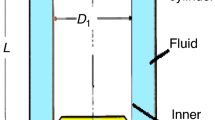Summary
Measurements were made on solutions of Polyethylene oxide (WSR-301) varying in concentration from .0511 g/dl to 4.014 g/dl, prepared from two samples of dry material of different ages (I, II), using aWeissenberg Rheogoniometer with cone-and-plate and parallel-plate geometries, and also using capillary viscometers. Steady shear data were obtained for eight decades of strain-rates (10−3 <k < 105 sec−1), and oscillatory data for over four decades of frequency (10−3 <f < 101 Hz). Results are presented for the shear-dependent viscosity,η(k), normal stress differences,σ 1(k), σ2(k), and the complex viscosity,η *(f). It was found that characteristic fluid times obtained from continuum arguments correlated the experimentalη(k), η′(f) andG′(f) data.
Using theη *(f) data, the stress relaxation function,Ψ(σ), was calculated, from which the second-order fluid coefficientsγ andη 0 were obtained, and compared to the directly measured values.
Evidence is given to show that the sign ofσ 1(k) varies both with concentration and strainrate.
Using solutions prepared from sample II, correlations with the material properties of solutions of sample I were found which indicated the effect of aging on stored dry samples.
Zusammenfassung
Es wurden Viskositätsmessungen an Polyäthylenoxid-(WSR-301)-Lösungen mit Konzentrationen zwischen 0,0511 g/dl und 4,014 g/dl ausgeführt, die aus zwei Proben von Trockenmaterial verschiedenen Alters (I, II) genommen waren. Verwendet wurde einWeissenberg-Rheogoniometer mit Kegel-Platte- und Parallel-Platten-Geometrie sowie verschiedene Kapillarviskosimeter. Werte für die stationäre Scherung wurden über acht Dekaden der Schergeschwindigkeit (10−3 <k < 105 s−1) erhalten, solche für periodische Beanspruchung über mehr als vier Dekaden der Frequenz (10−3 <f < 10 Hz). Es werden die Werte der Scherviskositätη(k), der Normalspannungsdifferenzenσ 1(k) undσ 2(k) sowie der komplexen Viskositätη *(f) mitgeteilt. Man findet, daß die experimentell ermittelten Werte vonη(k), η′(f) undG′(f) mit Hilfe charakteristischer Zeitkonstanten, die man aus kontinuumsmechanischen Überlegungen gewinnt, korreliert werden können.
Aus dem Verlauf vonη *(f) wurde die SpannungsrelaxationsfunktionΨ(σ) berechnet, woraus sich die Koeffizienten zweiter Ordnungγ undη 0 bestimmen lassen. Diese wurden mit den auf direkte Weise gewonnenen Werten verglichen. Es wird nachgewiesen, daß das Vorzeichen vonσ 1(k) sowohl bei der Veränderung der Konzentration als auch der Deformationsgeschwindigkeit wechselt.
Durch Vergleich der an den Proben I und II erhaltenen Ergebnisse wird auf Alterungserscheinungen bei der trocken gelagerten Probe geschlossen.
Similar content being viewed by others
References
Coleman, B. D., H. Markovitz, andW. Noll, Viscometric Flows of non-Newtonian Fluids (Berlin-Heidelberg-New York 1965).
Coleman, B. D. andW. Noll Arch. Ratl. Mech. Anal.3, 289 (1959).
Truesdell, C. andW. Noll, Non-Linear Field Theories of Mechanics, Handbuch der Physik (Berlin-Heidelberg-New York 1965).
Coleman, B. D. andH. Markovitz J. Appl. Phys.35, 1 (1964).
Coleman, B. D. andW. Noll Rev. Mod. Phys.33, 239 (1961).
Walters, K., Basic Concepts and Formulae for the Rheogoniometer (1968).
Truesdell, C. A. Phys. Fluids7, 1134 (1964).
Bruce, C. A. andW. H. Schwarz J. Polymer Sci. Pt. A-2,7, 909 (1969).
Norman, C. R. andA. C. Pipkin Trans. Soc. Rheol.11, 335 (1967).
Castro, W. andW. Squire Appl. Sci. Res.18, 81 (1967).
Virk, P. S., E. W. Merrill, H. S. Mickley, K. A. Smith, andE. L. Mollo-Christensen, J. Fluid Mech.30 (1967).
Stone, F. W. andJ. J. Stratta Encyclopedia of Polymer Sci. and Tech.6, 103 (1967).
Middleman, S., The Flow of High Polymers, (New York, 1968).
TheWeissenberg Rheogoniometer, Instruction Manual Model R. 18 (1964).
Walters, K. andR. A. Kemp Rheol. Acta7, 1 (1968).
Boger, D. V. andA. V. R. Murthy Trans. Soc. Rheol.13, 405 (1969).
Bruce, C. A., Viscometric Properties of Viscoelastic Fluids. Ph. D. Dissertation Stanford University (1969).
Flory, P. J., Principles of Polymer Chemistry (Ithaca, N. Y. 1953).
Rodriquez, F. andL. Goettler Trans. Soc. Rheol.8, 3 (1964).
Bueche, F., Physical Properties of Polymers (New York, 1962).
Brenner, N. M., Tech. Note 1967-2, M.I.T. Lincoln Laboratory.
Cooley, J. W., P. A. W. Lewis andP. D. Welch J. Sound Vib.12, 315 (1970).
Olabisi, O. andM. C. Williams Trans. Soc. Rheol.16, 727 (1972).
Pipkin, A. C. andR. I. Tanner, Mechanics Today1, 262 (1972).
Author information
Authors and Affiliations
Additional information
With 19 figures and 1 table
Rights and permissions
About this article
Cite this article
Powell, R.L., Schwarz, W.H. Rheological properties of polyethylene oxide solutions. Rheol Acta 14, 729–740 (1975). https://doi.org/10.1007/BF01515932
Received:
Issue Date:
DOI: https://doi.org/10.1007/BF01515932




